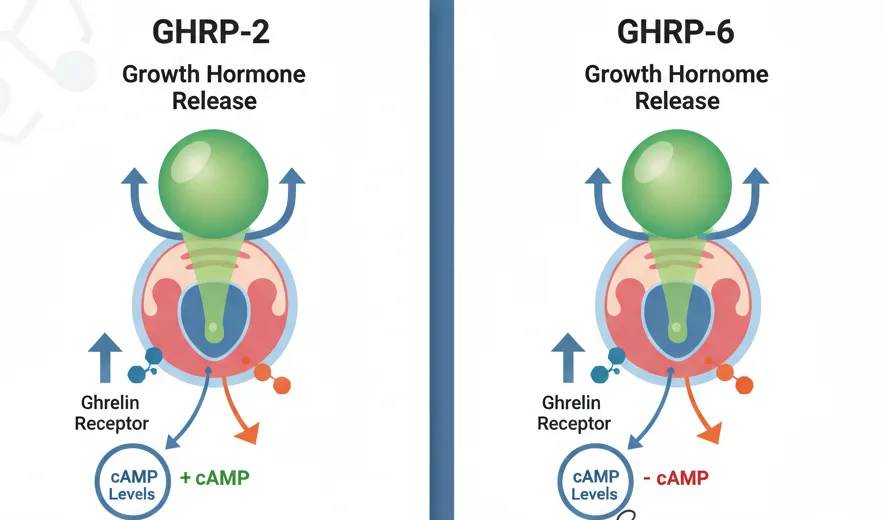Growth Hormone-Releasing Peptides (GHRPs) are a class of synthetic secretagogues that stimulate the body's natural production and release of growth hormone (GH) from the pituitary gland. Among the most well-known are GHRP-2 and GHRP-6, often discussed in contexts related to research into body composition, anti-aging, and recovery. While both peptides aim to increase GH levels, they exhibit distinct mechanisms and characteristics that differentiate their effects.
Core Function: Growth Hormone Secretion
At their fundamental level, both GHRP-2 and GHRP-6 act as agonists for the ghrelin receptor (also known as the GHS-R1a receptor). Ghrelin is a naturally occurring hormone primarily produced in the stomach, often dubbed the "hunger hormone," which also plays a crucial role in stimulating GH release. By mimicking ghrelin, these synthetic peptides bind to the same receptors in the pituitary gland and hypothalamus, triggering a pulsatile release of growth hormone.
Despite this shared primary function, their nuances lie in their secondary effects and the intracellular signaling pathways they influence.
Key Differentiator: Intracellular Signaling (cAMP Levels)
The most significant distinction highlighted in scientific literature, and directly mentioned in our reference, concerns their impact on intracellular adenosine 3',5'-monophosphate (cAMP) levels within pituitary cells:
-
GHRP-2 and cAMP: GHRP-2 has been observed to increase intracellular cAMP concentration. This mechanism is similar to how Growth Hormone-Releasing Factor (GRF), also known as GHRH (Growth Hormone-Releasing Hormone), functions. GRF/GHRH is the body's primary hypothalamic hormone responsible for stimulating GH release; it exerts its effects largely through the activation of adenylate cyclase, leading to increased cAMP levels. By elevating cAMP, GHRP-2 may synergize more directly with the GRF/GHRH pathway, potentially amplifying the GH pulse.
-
GHRP-6 and cAMP: In contrast, GHRP-6 causes a decrease in cAMP levels. While this might seem counterintuitive for a GH secretagogue, it indicates that GHRP-6 activates different downstream signaling pathways or modulates existing ones in a distinct manner. The exact implications of this decrease in cAMP for GH release might involve other secondary messengers or regulatory loops within the cell that ultimately converge on stimulating GH exocytosis, but via a different route than GHRP-2 or GRF/GHRH.
In essence, while both peptides ultimately lead to GH release, they do so by manipulating different aspects of the cellular signaling machinery within the pituitary gland.
Additional Distinguishing Characteristics
Beyond the cAMP mechanism, research often points to other practical differences:
-
Potency and Efficacy: While both are potent GH secretagogues, some studies suggest GHRP-2 might elicit a slightly stronger GH response than GHRP-6 at equivalent doses, possibly due to its GRF/GHRH-like cAMP-increasing mechanism. However, individual responses can vary.
-
Appetite Stimulation: GHRP-6 is more widely recognized for its profound appetite-stimulating effects. This is directly related to its ghrelin mimetic action. Ghrelin is a potent orexigenic (appetite-stimulating) hormone, and GHRP-6 appears to activate these pathways more noticeably, leading to significant increases in hunger shortly after administration.
-
GHRP-2 also has appetite-stimulating properties, but these are generally considered less pronounced or rapid compared to GHRP-6. Users of GHRP-2 might experience an increase in appetite, but it's typically less intense than with GHRP-6.
-
Side Effects and Purity: As with any research peptide, purity and potential side effects are concerns. Both can lead to common GH-related side effects such as increased water retention, tingling in extremities, and elevated cortisol or prolactin levels in some individuals, particularly at higher doses. However, specific side effect profiles can subtly differ due to their unique molecular interactions.
Summary Table
Conclusion
Both GHRP-2 and GHRP-6 are effective growth hormone-releasing peptides, but they are not identical. Their divergence in modulating intracellular cAMP levels points to distinct downstream signaling pathways that lead to GH secretion. Practically, the most noticeable difference for researchers and users often lies in their impact on appetite, with GHRP-6 generally eliciting a much stronger hunger response. Understanding these differences is crucial for anyone considering their use in research or other applications.

